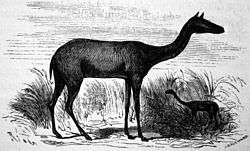Xiphodontidae
| Xiphodontidae Temporal range: 40.4–28.1 Ma | |
|---|---|
 | |
| Restoration of Xiphodon gracilis from 1863 | |
| Scientific classification | |
| Kingdom: | Animalia |
| Phylum: | Chordata |
| Clade: | Synapsida |
| Class: | Mammalia |
| Order: | Artiodactyla |
| Suborder: | Tylopoda |
| Family: | †Xiphodontidae |
| Genus | |
|
†Dichodon | |
Xiphodontidae is an extinct family of even-toed ungulates (order Artiodactyla), endemic to Europe during the Eocene 40.4—33.9 million years ago, existing for about 7.5 million years.[1] They were, most likely, all terrestrial herbivores. Paraxiphodon suggests that they survived into the Lower Oligocene, at least.[2]
Taxonomy
The Xiphodontidae were named by Flower (1883). It was assigned to Artiodactyla by Cope (1889); to Xiphodontoidea by Hooker (1986); and to Tylopoda by Carroll (1988).[3][4]
See also
- List of Camelids
References
- ↑ PaleoBiology Database: Xiphodontidae, basic info
- ↑ Prothero, D.R.; Foss, S.E. (2007). The Evolution of Artiodactyls. Johns Hopkins University Press. ISBN 9780801887352. Retrieved 2014-10-08.
- ↑ J. J. Hooker. 1986. Mammals from the Bartonian (middle/late Eocene) of the Hampshire Basin, southern England. Bulletin of the British Museum (Natural History) 39(4):191-478
- ↑ R. L. Carroll. 1988. Vertebrate Paleontology and Evolution. W. H. Freeman and Company, New York 1-698
This article is issued from Wikipedia - version of the 10/13/2016. The text is available under the Creative Commons Attribution/Share Alike but additional terms may apply for the media files.